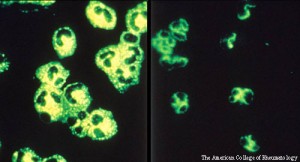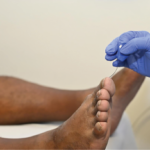 The collection of small-vessel vasculitides known as anti-neutrophil cytoplasmic antibody-associated vasculitides (AAV) can affect nearly every organ system. The different categories of vasculitis, including granulomatosis with polyangiitis (GPA), a life-threatening form of small-vessel vasculitis, were described in the 2012 Revised International Chapel Hill Consensus Conference Nomenclature of Vasculitides. Since the 1980s, rheumatologists have treated AAV patients with a combination of daily cyclophosphamide and alternate-day prednisone therapy. For many patients, this approach has successfully induced and maintained long-term remission. Recent trends in treatment have emphasized less cumulative cyclophosphamide exposure and greater use of azathioprine and other steroid-sparing agents.1
The collection of small-vessel vasculitides known as anti-neutrophil cytoplasmic antibody-associated vasculitides (AAV) can affect nearly every organ system. The different categories of vasculitis, including granulomatosis with polyangiitis (GPA), a life-threatening form of small-vessel vasculitis, were described in the 2012 Revised International Chapel Hill Consensus Conference Nomenclature of Vasculitides. Since the 1980s, rheumatologists have treated AAV patients with a combination of daily cyclophosphamide and alternate-day prednisone therapy. For many patients, this approach has successfully induced and maintained long-term remission. Recent trends in treatment have emphasized less cumulative cyclophosphamide exposure and greater use of azathioprine and other steroid-sparing agents.1
Although AAV patients appear to be responding to newer treatment approaches, they still have an increased risk of mortality relative to the general population. Example: In 2016, investigators reported a 2.7-fold increase in mortality among patients with AAV relative to the general population.2
That same year, another population-based study found that although the survival of GPA patients had improved considerably over the past two decades, it still had a hazard ratio of mortality of 2.5, which was somewhat lower than previous reports.3 However, the study was limited, relying on physician diagnoses of GPA unconfirmed by pre-specified criteria. Nevertheless, the study was one of the largest of a population-based cohort to evaluate mortality in patients diagnosed with GPA. GPA had previously been associated with increased mortality due to the disease itself, as well as complications due to treatment.This study affirmed the benefits of recent trends in GPA and AAV management.
Recently, Alexander W. Steinberg, MD, an internal medicine specialist at St. Joseph Hospital, Denver, and Michael E. Wechsler, MD, MMSc, a pulmonologist at National Jewish Health, Denver, sought to describe age-adjusted AAV mortality trends in the U.S. across demographic groups and geographic regions. For this analysis, they examined the multiple-cause-of-death records from the Centers of Disease Control & Prevention’s Wide-Ranging Online Data for Epidemiologic Research Database from 1999 to 2017. The results were published Oct. 8 in the Annals of Internal Medicine.4
The investigators found that from 1999–2017 11,316 AAV-related deaths occurred in the U.S. They calculated an age-adjusted mortality rate of 1.86 per 1 million people.
“Our results provide novel insights into mortality in persons with AAV in the U.S. between 1999 and 2017,” write the authors. “During this period, the age-adjusted AAV mortality declined by nearly 2% per year. The decrease in overall mortality and mortality among persons aged 65 to 74 years may reflect increased longevity due to improved treatment of AAV and common comorbid conditions.”

